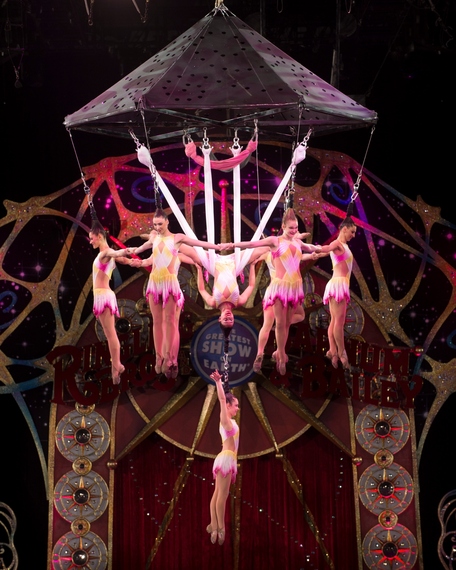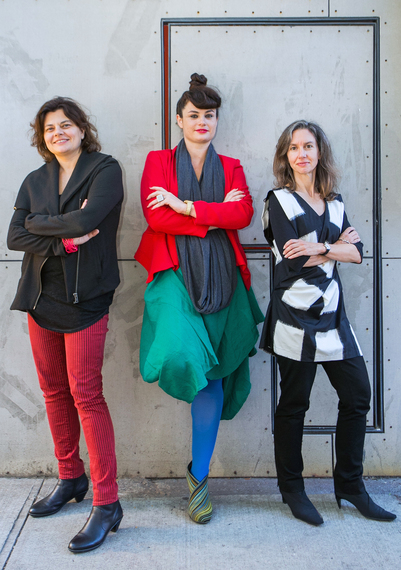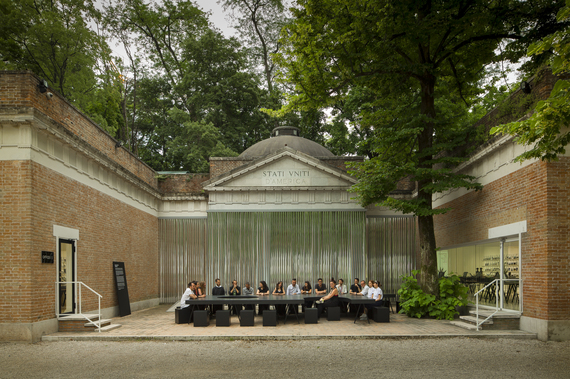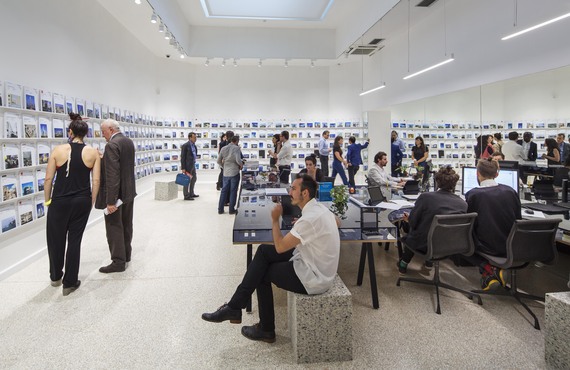The Gift-Challenge
"Life drawing" is an accepted term for making drawings from direct observation of (often nude) models. In any major American city, you can find uninstructed, open-to-the-public life drawing workshops without too much effort. You show up with your pencil and your sketchbook, you pay your fifteen dollars, and you draw for three hours.
I am self-taught as a figurative painter, and the major means of my self-teaching has been such life drawing workshops, first in Los Angeles and then in New York. I have been attending them, on average, twice a week, since 1998. Going by the boxes I keep them in, the drawings I have produced in that time would be around 75 inches tall if stacked atop one another - taller than I am.
![2014-06-05-graphic1.jpg]()
Daniel Maidman, Preparatory Sketch for Meiosis VI, pencil on paper, 15"x11", 2014
As some of you know, I scan and post most of my life drawings to Facebook. In my current folder, "Selected Drawings: 2014," I received the following comment a few days ago:
![2014-06-05-graphic2.jpg]()
Facebook comment, May 31, 2014
Jerry Saltz is the
senior art critic at
New York Magazine. We know one another a
bit. On the face of it, his comment is pretty harsh and dismissive. That's not the whole picture though. Saltz is compulsively extroverted over social media, but his seeming omnipresence doesn't mean he has infinite time. More people want Saltz to pay attention to more art than any one person can look at. So it's very flattering when he turns up to admit in public that he's been thinking about your work. By his standards, this is a reasonably long comment. All of that factors into its meaning.
What I read in it is that Jerry has been looking at my drawings over time, and mulling them over. He has an enormous framework of doctrines within which my work makes no sense, and yet he finds he either can't, or won't, ignore what I'm doing. In one sense, he is asking me to defend my work. But in another sense he is asking me to make my work available to him too. I would never say no to either request. The first makes us both stronger, and the second makes us both richer.
As it happens, I use Jerry as a handy stand-in for a set of concepts about art largely opposed to my own. As he likes me, so I like him. I don't need to agree with somebody to like them and consider what they have to say. He's pretty sharp, so when I'm figuring out in my mind how to describe what I do, I sometimes find it helpful to phrase it in terms of a response to Jerry's doubts. I had been planning this essay anyway. It's gratifying, though, to be replying to the actual Saltz, and not a fantasy stand-in.
I'm going to answer Jerry's questions by backing way up and taking a running leap at the subject.
![2014-06-05-graphic3.jpg]()
Daniel Maidman, Magic Reclining, Foreshortened, pencil on paper, 15"x11", 2013
Why We Life Draw: The Prior Erotic Force
The day after a bachelor party some years ago, I snarled to a buddy of mine, "That's the last time I go to a strip club." He said, "What's your problem with strip clubs?" I said, "I think they're tawdry and depressing, and overall, they're just not my favorite venue for hanging out with naked women." Pause. I looked over. A little vein was throbbing in his forehead. I said, "What?" He said, "Most of us don't have a
variety of venues where we hang out with naked women we're not dating."
This is a funny instance of the question one gets asked repeatedly about life drawing: aren't you really just using this as an excuse to hang out with naked women?
I've given this question a lot of thought, and here's what I think. I think that in a sense, yes, we are. Non-life-drawers often assume that life drawing involves a sideways translation of one impulse into another impulse:
![2014-06-05-graphic4.jpg]()
But this assumption is flawed. I read the sex drive as a powerful force, but a specific one. I think it is one channel into which a much more profound and general force can be diverted, which I label the prior erotic force: erotic, because it is the force of the life-drive itself, and prior, because it comes before all other forces. The sex process and the art process bear certain structural similarities, not because one is a simulacrum of the other, but because both have a common origin.
![2014-06-05-graphic5.jpg]()
A naked woman in the context of the art drive - and, if the artist is a straight male, and serious, a naked man - becomes the subject of an erotic craving, but that craving is not sexual. It is artistic. (1) It has to do not with physical reward, but with the enlightenment that we crave in knowledge of one another as human beings with human forms. The persistence of the figure in art from the first known art objects, down through the present, answers neither to sex nor to chance, but to spiritual necessity. We need to know one another, by means of sight. This will not become obsolete or irrelevant until the brain leaves behind its facial and body recognition circuitry (2), and the soul its desire for companionship and possession.
![2014-06-05-graphic6.jpg]()
Daniel Maidman, Leah Seated, Facing Away, pencil on paper, 15"x11", 2014
Excellence in Seeing: Life Drawing as Technê
In modern English, we would tend to draw a distinction between talent and skill. To illustrate the linked concepts, let's consider a clear instance of excellence in both, like superstar athlete Michael Jordan. It is Air Jordan's
talent that gives him the potential to become one of the greatest ninjas of his or any age. But it is only through years of training in
ninjutsu, such as by climbing mountains, collecting rare flowers, drinking hallucinogenic tea, and leaping from tree stump to tree stump while fighting multiple warriors with a stick, that he actualizes his talent by means of an acquired set of
skills.
This model of talent, which is inborn, and skill, which comes from training and experience, is useful in many contexts, but I think it doesn't quite serve our purposes here. Since we're talking about philosophy things, it seems sensible to turn to the Greeks for terminology. I'd like to re-introduce a Greek concept similar to skill, but not quite the same -
technê. (3)
The Greek
technê varies in meaning over time, but it seems to keep two essential components: a. it involves skilled action, and b. the action is performed in the context of a mindfulness in regard to the purpose of the action, which resides outside the action itself.
Technê is the workingman's
poiesis.
Aristotle distinguishes
technê from virtue (
aretê) in that the merit of
aretê does not lie in some exterior object. Virtuous people display
aretê by choice and character, and its end lies in itself and in their virtue of character. The account of life drawing above, as an activity rewarding in itself because of its relation to the prior erotic force, is an account of life drawing as
aretê. Many people with no further ambitions as artists partake of life drawing for this reason alone. It makes their lives better. It makes them happy.
But life drawing for the professional artist also has the character of a
technê. Its end lies not only in itself, but in that which is produced. There are two things produced, only one of which is obvious: the drawing. Of course these artists want to make beautiful drawings from their time in life drawing. We can argue beauty another time - for now, let's say that each artist approaches the
technê of life drawing with some exterior goal in mind, defined as beautiful/true/accurate/what-have-you (4), by the artist, and the artist strives toward this kind of beauty. The senses of beauty are as varied as the artists who approach the work. And the sense of beauty evolves over time in each artist as he or she discovers themselves through the work.
The less obvious end produced by life drawing as a
technê is "excellence in seeing." A moving quotation from Ruskin has been wending its way through the representational art community lately. He describes excellence in seeing very well.
Let two persons go out for a walk; the one a good sketcher, the other having no taste of the kind. Let them go down a green lane. There will be a great difference in the scene as perceived by the two individuals. The one will see a lane and trees; he will perceive the trees to be green, though he will think nothing about it; he will see that the sun shines, and that it has a cheerful effect; and that's all! But what will the sketcher see? His eye is accustomed to search into the cause of beauty, and penetrate the minutest parts of loveliness. He looks up, and observes how the showery and subdivided sunshine comes sprinkled down among the gleaming leaves overhead, till the air is filled with the emerald light. He will see here and there a bough emerging from the veil of leaves, he will see the jewel brightness of the emerald moss and the variegated and fantastic lichens, white and blue, purple and red, all mellowed and mingled into a single garment of beauty. Then come the cavernous trunks and the twisted roots that grasp with their snake-like coils at the steep bank, whose turfy slope is inlaid with flowers of a thousand dyes. Is not this worth seeing? Yet if you are not a sketcher you will pass along the green lane, and when you come home again, have nothing to say or to think about it, but that you went down such and such a lane. (5)
Note how eroticized his description of nature is - channeling the prior erotic force, as he does, not into figure drawing, but nature drawing - and also his implication that excellence of seeing helps to remedy an overly logocentric outlook: the sketcher has experienced the place, but his friend knows only its name.
The
technê of life drawing, then, consists in becoming excellent with regard to the ability to make a fine drawing, and the ability to see finely. These are not prerequisites for all kinds of art, but they are for certain kinds of art. New York artist
Jenny Morgan has this to say about life drawing: "I have a strong background in life drawing and painting. I have wavered in my practice the last few years, but I think of my life drawing experience every time I draw out my figures on canvas." Consider a couple of her life drawings which, much to my delight, she shares in public here for the first time:
![2014-06-05-graphic7.jpg]()
Jenny Morgan, untitled life drawings, pencil on paper, 2006
She follows certain classic strategies here for comprehension of the figure. On the left, you can see how she started with light lines down the structural centers of the torso, arms, and legs. Additionally, she marked the frontward tilt of the top plane of the pelvis. With these spatial markers laid in, she went on to loosely outline the body around them, confident that she would have the proportions and positions about right while depicting the body as a single cohesive unit.
She pursues the same strategy in the figure on the right. She starts with the angle of the spine, the key curves of the ribcage in perspective around it, and the core lines of the legs. She uses here another nearly-universal life drawing strategy: for the mass of the pelvis and butt, she sketches out an ovoid, lightly defining a general mass before elaborating it with the darker outlines of the hips.
She summarizes the work thus: "I never get super detailed or in depth with my sessions - I've always enjoyed the freedom of fast, loose studies." It is this practice of life drawing which gave her part of the
technê required to express her particular form of forceful creativity, as she does here:
![2014-06-05-graphic8.jpg]()
Jenny Morgan, You to Me, oil on canvas, 92" x 78", 2013
Her vision as an artist involves a conflict between image and its erasure. She localizes the conflict in the figure, but her sense of erasure is not universal across the image, as it is with Richter. Rather, it has a psychosexual topography: the face tends to fade, while hair and nipples and hands retain detail. This complex effect is impossible, in the form unique to Morgan, without the viewer unquestioningly "buying" her figures. Her seemingly effortless, fluid figuration results from the
technê she has developed in life drawing and other art-auxiliary practices.
To restate from this specific instance, to the general principle: Practice in life drawing provides the necessary
technê for the full-flowered
poiesis of art-making itself. If
poiesis is the making of a new thing in the world, a microscopic recapitulation of the creation of the universe, then life drawing and related species of practice provide the artist-demiurge with the mighty powers required by the task.
What About the Viewer?
OK, great. But why should anyone actually look at a life drawing?
Let's consider again the example of Michael Jordan. Say he's in his dojo in the morning, practicing his
dakentaijutsu with a sparring partner, or even just running the Eight Gates on a mannequin. His Airness must practice daily in order to keep sharp. Because of the supreme development of his bushido, his form takes on a grace of its own, quite apart from any utility it might have in fighting the criminal element. Thus a viewer could well take joy simply in the spectacle of the focused practice of this master.
We turn our gaze from Jordan to his spectator. What capacity in the spectator provides him or her with the ability to take joy in the spectacle of Jordan's practice? There must be two possibilities at least. Either the spectator can take joy in beautiful things in and of themselves, for no reason further than excellence of form relative to the aesthetics of the medium, be it a well-made table, a beautifully-played bit of music, or a display of gymnastic prowess - or the spectator takes joy in the excellence of the constituent parts of more elevated things: that is, while Jordan is merely practicing, the excellence of his practice serves as a constituent part of his more elevated goal (striking fear into the hearts of the criminal element).
Very much of a similar thing applies to the viewer of a life drawing - and I know this, because I have spoken with my collectors about it. In some cases, they merely like beautiful things, and what strikes me as beautiful in my pursuit of life drawing strikes them as beautiful in their appreciation of it. In other cases, they value the life drawings as building-blocks from which more fully-fledged art is constructed. These people appreciate the fruit of
technê inasmuch as it is a portent and kernel of the fruit of
poiesis.
And, because little in life is really so categorically clean, once in a while a life drawing transcends its nature and takes on the qualities of art
per se. And that is a fine thing too.
![2014-06-05-graphic9.jpg]()
Daniel Maidman, Preparatory Sketch for Blue Leah #2, pencil on paper, 15"x22", 2011
To Answer Your Questions, Jerry
Running leap: done!
Having built up a context for this conversation, I can now address your note properly:
>Your skill is extraordinary.
Thank you!
>I ask this 100% sincerely.
>Is this 'art' though?
It is not art, and not not-art. It is the product of
technê. Without it, much that you see as art could not exist; and yet it is also worthwhile in itself.
>Isn't it just so-called academic figuration?
This is really the crux, isn't it? That "just" tips your hand. If I say "yes," then you dismiss it, because you dismiss academic figuration categorically - you've set it up as existing in opposition to 'art.' But if I say "no," then I have to explain why not, and implicitly sanction the categorical dismissal. I'm not in the market for either of these options.
This happens not to be academic figuration, because I see academic figuration as pursuing a convergent goal: that is, the perfected course of academic study would lead all students, presented with the same visual field and the same assignment of a fully-rendered drawing, to make approximately the same representation. This would demonstrate successful acquisition of a certain skill-set. And I think that this extraordinarily challenging skill-set is worth acquiring. It is a model of total skill as yielding total freedom. This Earth-shaking skill-set is so profound, in fact, that its apotheosis is not yet born. Bouguereau was the Isaiah of academic art, one might say, or its John the Baptist. We are still waiting on its Christ.
But it is not for me, and that's not what I'm doing.
I'm part of a completely chaotic and un-self-aware faction of divergent life-drawers; our work tends to become more distinct over time. But these distinctnesses, like all distinctnesses within a genus, are available only in the context of some knowledge of the genus. One cannot distinguish Handel from Mozart on day one, nor the Ramones from the Sex Pistols.
>I do not question your ability, desire, etc.
>I really like you too.
Let me point out here that one of the great rewards of my life as an artist in New York has been the opportunity to get to know you a bit, and to expand the boundaries of my tolerance by challenging it with your opinions. I do not always, or even often, agree with you, but you have done so much to expand the art available to me, and I am profoundly grateful for that.
>But when I look at this something inside of me dies.
However: this response is not legitimate. It is a failure in you, and it should raise all of your red flags. There is no room in a serious appreciation of art for categorical dismissal, because all categories simply represent sets of aesthetic rules and references. That is, all categories are languages. The language is not the text. A worthwhile text may be written in any language. It is acceptable for a tourist or a layman to ignore a text because they dislike the sound of a language - but it is not acceptable for a serious thinker -
>Again, I do not say this with any meanness or with intent to insult.
- sure, sure - I'm thick-skinned too; no worries -
>This is only about MY tatse, my eye.
>Many will just say my tatse is in my ass & I have no idea about art.
>They could be right.
- and my feeling is that you are, or try to be, a serious thinker about art. You have a responsibility to transcend your taste, to drive your taste beyond your inclinations. A tourist or a layman does not have such a responsibility, but you went out seeking authority as a critic, and you earned it. That authority comes with responsibilities, and one of them is to figure out
what it is about the things you don't, by inclination, like.
Now, that said, I think that when you turned up at my drawing folder out of the blue, and left your comment, you were actually working on this very project. I believe that the boundaries of your taste are no longer sufficient for your comfort, and that you are trying to grow, just as I am trying to grow. Contrast two statements of yours. Here's you in 2005:
"...to me 'de-skilled' means unlearning other people's ideas of what skill is and inventing your own. All great artists (schooled or not) are essentially self-taught and are 'de-skilling' like crazy. I don't look for skill in art; I look for originality, surprise, obsession, energy and something visionary. Skill only means technical proficiency. Real skill has to do with being flexible and creative. ... I'm interested in people who rethink skill, who redefine or re-imagine it: an engineer, say, who builds rockets from rocks." (6)
And here's you at the end of last year:
"Call me conservative, but it's also time for grad programs to stress courses in craft and various skills -- from blacksmithing to animal tracking, if these are things students need to learn for the visions they want to pursue." (7)
This reads to me as an evolution in thinking. The evolution is toward an acceptance that it is not necessary every single time to re-invent the wheel or to go back to the stone age and make a rocket from rocks - an acceptance that for many kinds of art,
technê is the scaffold on which originality and vision are built.
Consider, though, a second thing: even in December of 2013, you cannot quite bring yourself to write down what crafts and skills you really mean. You choose awkward and unlikely skills, feigning random selection off the top of your head. But there are already schools for blacksmithing and animal tracking, and they're not offering MFA's in fine art. The skills you cannot bear to name are drawing, painting, and sculpture.
Now it is June of 2014, and we have not traded ideas in a while, but I come to find you are looking at my drawings, and considering them, and trying to make heads or tails of what I'm doing and why it makes you feel as it does. This strikes me as another step in your evolution. I think, just as I have moved toward seeing art your way since we first met, you have been moving toward seeing it my way as well.
Your way is not a threat to my way. There is room enough in me for both. My way is not a threat to your way either. There is room in you, too, for rockets made from rocks, and rockets made from steel; I am not your enemy.
![2014-06-05-graphic10.jpg]()
Daniel Maidman, Drawing of Kuan #5, pencil on paper, 15"x11", 2014
Counter-Gift-Challenge
I have tried to accept your gift here, and meet your challenge: to explain myself, and in explaining, make my ethos more available to you as well. I have no idea how far I've gotten but, like you, I am 100% sincere.
Now let me return the favor, and offer you a gift-challenge in return. Come sit with me once a week, for five weeks, for three hours at a time. We will hire a model, and life draw for two hours, with an hour mixed in for talking it over. I will teach you. I won't teach you a lot, because I'm no kind of a teacher. But I can articulate one or two things, and help you try out doing what I do. I will, of course, be very interested to learn from you in the course of this as well. And we will both learn from our models.
A few conditions go along with this offer:
1. You've got to complete all five weeks.
2. You have to write a bit about your experience.
3. You have to show the drawings you make.
Let me address your objections as best I can anticipate them:
You're chained to your desk - I know. But this is important, Jerry. Seeing art, knowing art, and loving art are terribly important to you. This is an opportunity you haven't had in a long time, not only to expand the range of your taste, but the fineness of your eye. The hand profoundly trains the eye, and the hand goes with technê. Working as I work will refresh and deepen your eye. With your hand still stinging from its exercise, you will bring new insight to all the art you look at. You will see new subtleties of form, new potentialities. Everything will be renewed. That is worth the price in time. This is an adventure.
Your writing schedule is full. Fine - cram it in around the corners somewhere. This is a fun idea. Jerry Saltz, his sketchbook, his figurative painter
semblable/frère, some naked people, and a world of concepts to grapple with. It's a good story. It's your kind of stunt. Write rough sketches each week: notes on what you see and do, and feel and learn. Embrace that your outlook is changing. Repudiate nothing but accept everything.
You are a critic and you do not show your art. Let me add to this - your drawings will most likely be terrible, from a technical perspective. You will be tempted to label the deformities of their technique as examples of personal creativity and expression. But just this once, you should not do that. You should say, proudly, "These drawings are terrible! I tried to do a particular thing with them, and I failed!" This is the magnificence of
aretê in life drawing, of self-rewarding virtue. You are not here to do a good job - you are only here to try, and to learn from your trying. What glory is this? It is an opportunity to learn as a child learns, without preconception, without expectation, without fear.
- you do not show your art. Make yourself radically vulnerable. Nobody needs you to be good at it in any sense. The validity of your criticism does not rest on your prowess as an artist or a technician. I cannot stress enough how liberating it is to welcome humiliation. It will resound through the rest of your life. It will shake loose your sense of how things must be. Opportunity will flower everywhere.
Besides, you can totally auction off the work and give the money to an art scholarship.
Please let me give this back to you. You have walked over to me. I am walking back over to you. Let's walk together a little ways.
All best wishes,
Daniel Maidman
![2014-06-05-graphic11.jpg]()
Daniel Maidman, Preparatory Sketches for Meiosis III and IV, pencil on paper, each approx. 15"x11", 2013
--
ENDNOTES:
(1) For an account of my subjective experience of this phenomenon, see
here.
(2) For an introduction to the neurological basis of the phenomena described, see Dr. Margaret Livingstone's faculty page
here and buy her amazing book
here.
(3) I rely in the material that follows on the excellent discussion of
epistêmê and
technê here.
(4) What I really mean is my idiolectic term 'kalos," discussed
here.
(5) From "The Elements of Drawing, in Three Letters to Beginners by John Ruskin" as quoted
here.
(6)
http://www.frieze.com/issue/article/writing_wrongs/
(7)
http://www.vulture.com/2013/12/saltz-on-the-trouble-with-the-mfa.html














































